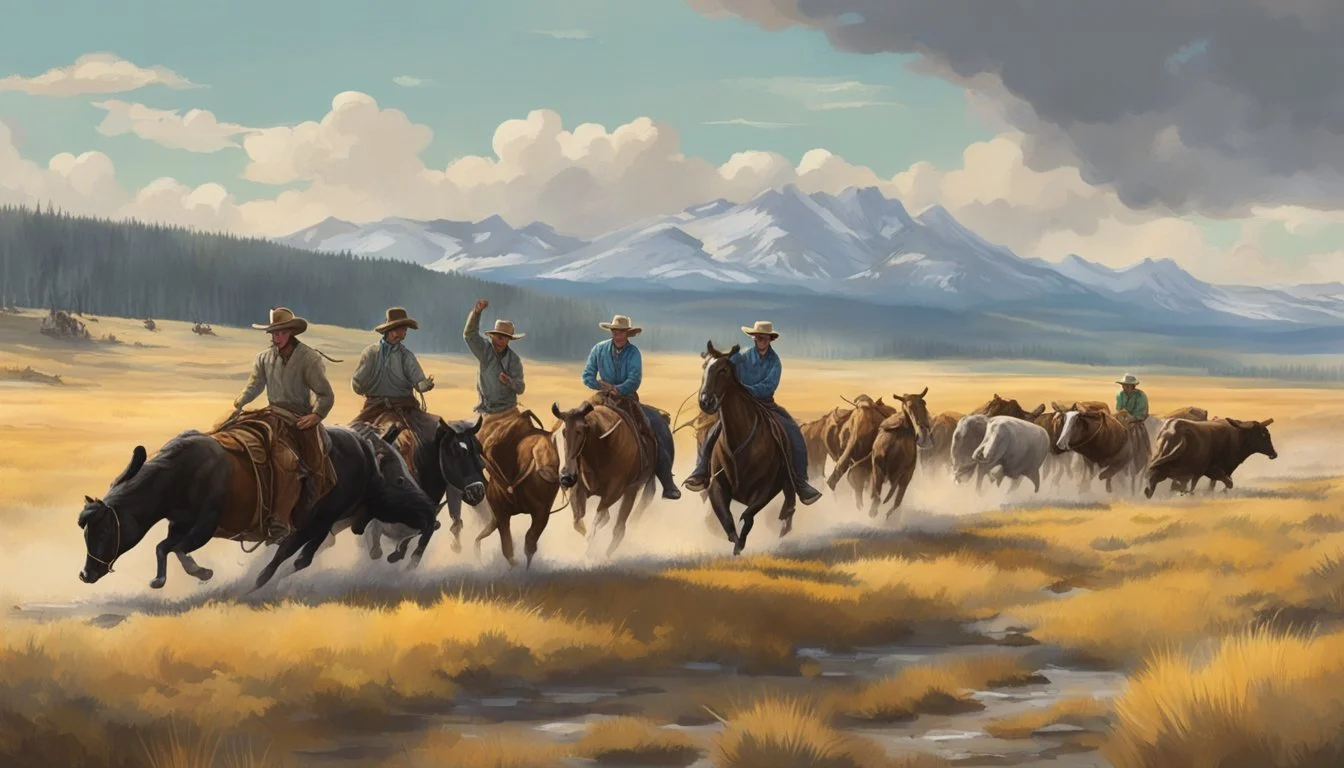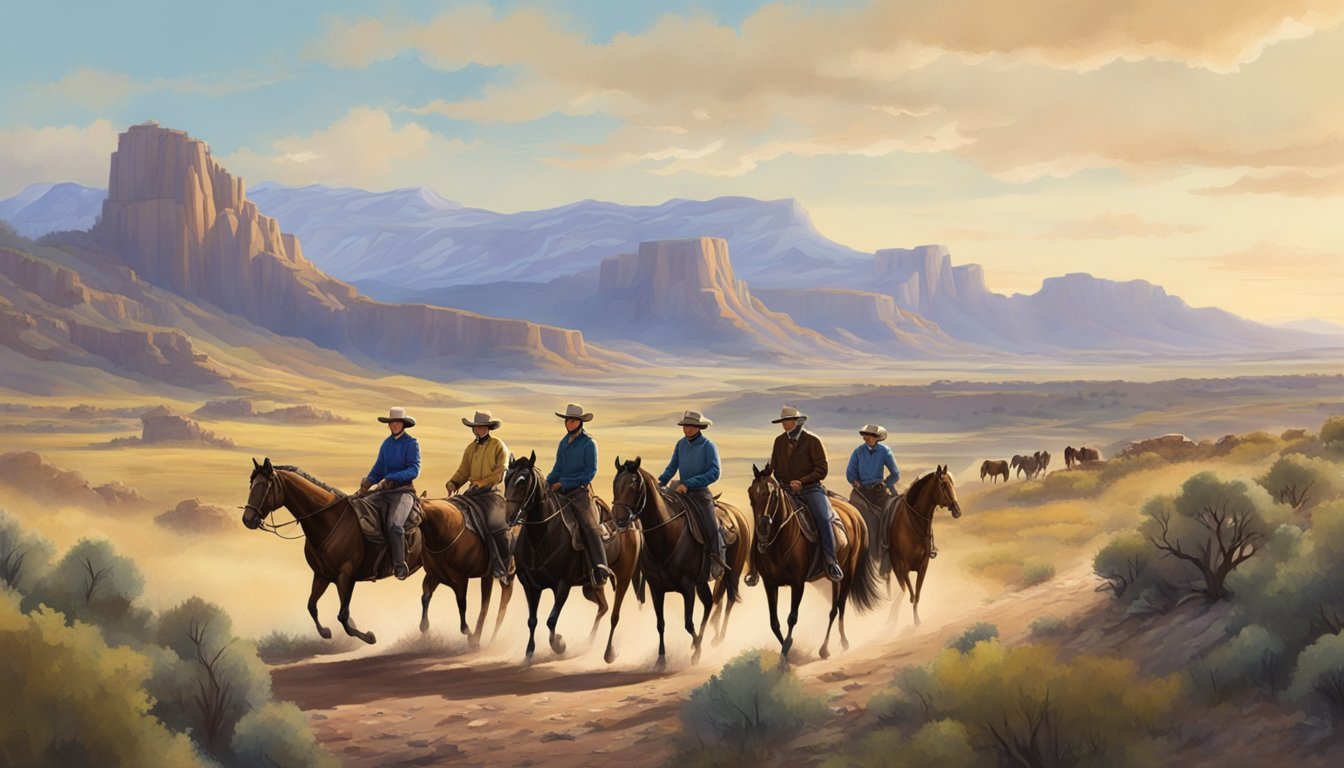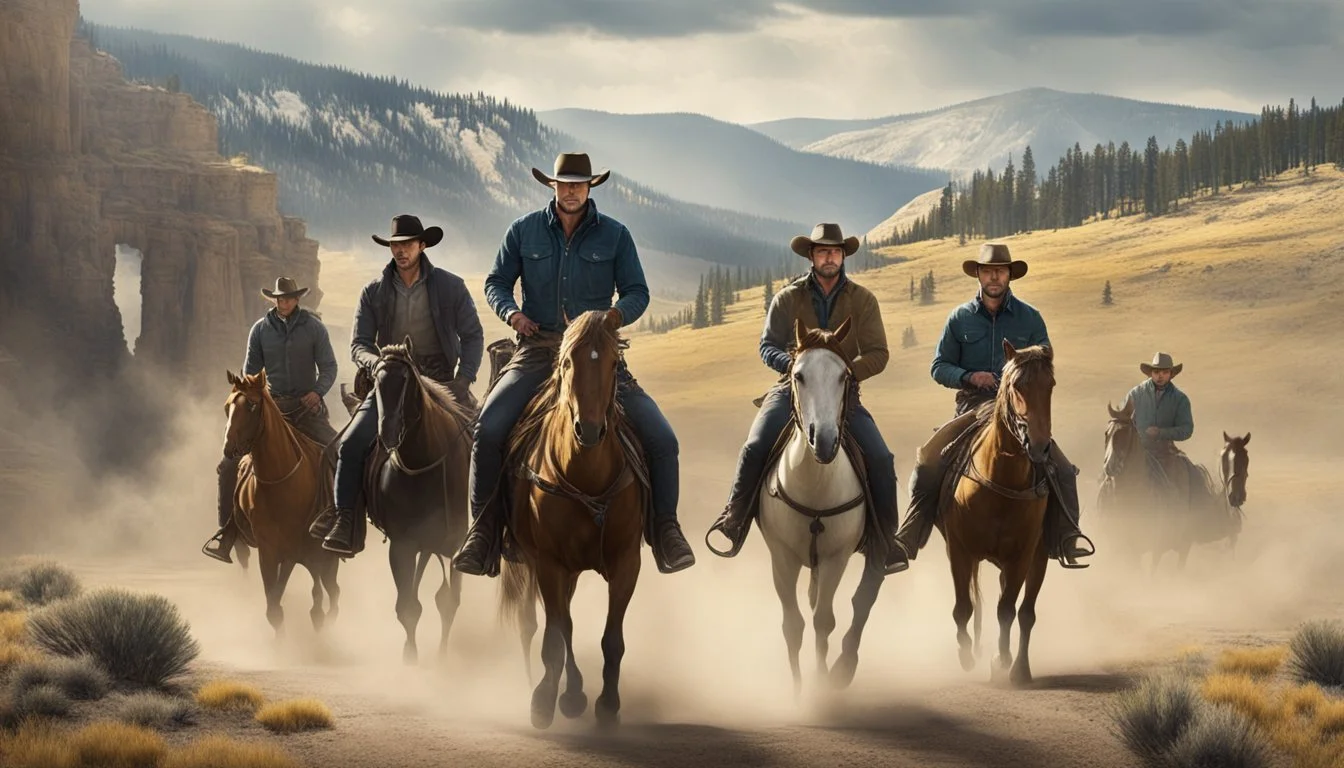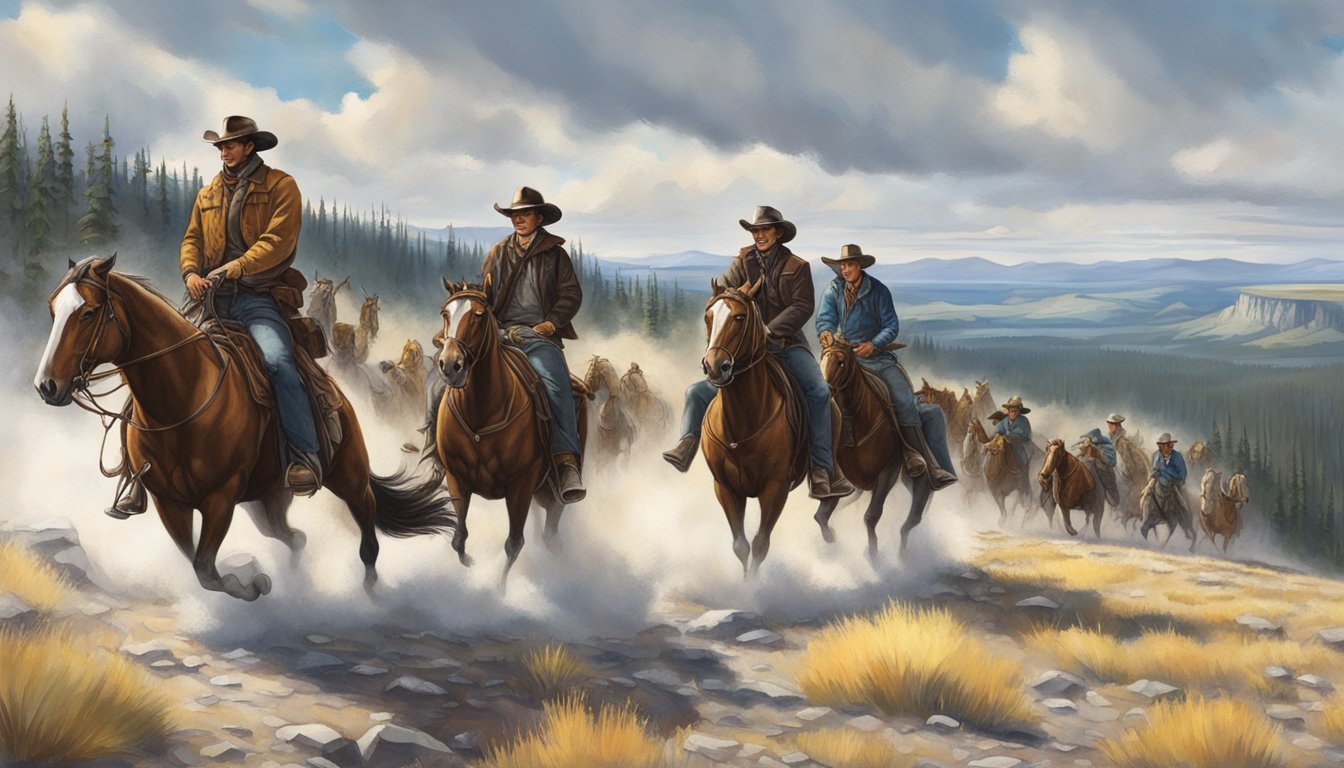Discover the Powerful Cattle Breed Behind Yellowstone's Epic Ranching Saga
The hit TV series Yellowstone captivates viewers with its portrayal of a sprawling Montana cattle ranch. While the show's dramatic storylines often take center stage, the cattle themselves play a crucial role in bringing authenticity to the ranching world depicted on screen.
The Yellowstone Dutton Ranch primarily raises Black Angus cattle, a breed well-suited to the harsh Montana climate. Black Angus are known for their hardiness, efficient feed conversion, and high-quality beef production. This choice reflects the practical considerations real ranchers face when selecting livestock for their operations.
Yellowstone's creators have put considerable effort into accurately representing modern ranching practices. The show depicts various aspects of cattle management, from branding and breeding to driving herds across vast expanses of rugged terrain. While some dramatic liberties are taken for entertainment purposes, the series generally provides viewers with a glimpse into the challenges and complexities of running a large-scale cattle operation in the American West.
Origins of the Dutton Ranch
The Dutton Ranch stands as a symbol of Montana's rich ranching heritage. Its roots trace back to the early settlement of the region, with the Dutton family playing a pivotal role in shaping the land and community.
Historical Context
The Dutton Ranch's origins date to the late 19th century when Montana's cattle industry began to flourish. Large-scale ranching operations emerged as railroads expanded westward, providing access to eastern markets. The ranch's vast acreage encompassed prime grazing land, vital water sources, and strategic locations for cattle drives.
Early ranchers faced numerous challenges, including harsh winters, conflicts with Native American tribes, and competition for resources. The Dutton ancestors likely weathered these obstacles, establishing their foothold in the region through determination and resilience.
Dutton Family Ancestry
John Dutton's forebears were among the pioneering ranchers who settled in Montana. The family's ranching legacy spans multiple generations, with each passing down knowledge, skills, and a deep connection to the land.
The Duttons built their empire through strategic land acquisitions, savvy business decisions, and a reputation for producing high-quality cattle. Their influence grew beyond ranching, extending into local politics and community leadership.
Over time, the Dutton name became synonymous with Montana ranching. John Dutton inherited not just land and cattle, but also the weight of family tradition and the responsibility to preserve their legacy in a changing world.
Bovine Cast of Yellowstone
The cattle featured on Yellowstone play a crucial role in bringing authenticity to the show's portrayal of ranch life. Specific breeds are chosen to reflect the realities of modern ranching while also serving the dramatic needs of the series.
Breeds Featured on the Show
Yellowstone primarily showcases Angus and Hereford cattle, two breeds well-suited to the harsh Montana climate. Angus cattle, known for their black coloration, are prized for their high-quality beef and adaptability. Herefords, with their distinctive red bodies and white faces, are renowned for their hardiness and efficient grazing.
The show also features crossbred cattle, which combine desirable traits from different breeds. These crossbreeds often display improved vigor and productivity, reflecting modern ranching practices.
Significance of Breed Selection
The choice of cattle breeds on Yellowstone serves both practical and storytelling purposes. Angus and Hereford cattle are widely used in real Montana ranches, lending credibility to the show's setting. Their presence underscores the Dutton Ranch's commitment to quality livestock and traditional ranching methods.
The breeding programs depicted in the show highlight the complexity of modern cattle ranching. By featuring specific breeds and crossbreeding efforts, Yellowstone illustrates the ongoing balance between tradition and innovation in the industry. This attention to detail in breed selection helps create a more immersive and authentic viewing experience for audiences.
Ranching Operations
The Yellowstone show depicts various aspects of managing a large-scale cattle ranch. Daily activities, modern ranching practices, and animal care form the core of the Dutton ranch's operations.
Day-to-Day Activities
Ranch hands start their days early, often before sunrise. They begin by checking fences and water sources for the cattle. Feeding routines vary by season, with supplemental hay provided during winter months. Cattle counts and health checks occur regularly.
Branding calves is a crucial task, typically done in spring. This process involves rounding up cattle, separating calves, and applying the ranch's unique brand. It helps with identification and prevents theft.
Pasture rotation is another key activity. Ranch hands move cattle between grazing areas to prevent overgrazing and maintain healthy grasslands.
Managing a Modern Cattle Ranch
Modern ranching blends traditional practices with new technologies. GPS tracking devices help monitor cattle locations and movements across vast territories. Drones assist in surveying land and locating stray animals.
Record-keeping software tracks animal lineage, health history, and production data. This information aids in breeding decisions and herd management.
Marketing and sales are crucial aspects of ranch management. Ranchers must stay informed about market trends and negotiate favorable prices for their livestock.
Environmental stewardship plays a significant role. Sustainable grazing practices and wildlife conservation efforts are integrated into ranch operations.
Animal Health and Welfare
Veterinary care is a top priority on cattle ranches. Regular health checks, vaccinations, and prompt treatment of illnesses or injuries ensure herd wellbeing.
Proper nutrition is essential. Ranchers carefully manage feed quality and quantity, adjusting diets based on cattle age, pregnancy status, and seasonal needs.
Stress reduction techniques are employed during handling and transportation. Low-stress handling methods improve animal welfare and meat quality.
Breeding programs focus on selecting traits that enhance animal health and adaptability to local conditions. This approach reduces the need for medical interventions and improves overall herd resilience.
Cultural Representation
Yellowstone portrays authentic aspects of modern ranching and cowboy culture. The show's depiction of rural life and traditions resonates with many viewers while also introducing these practices to wider audiences.
Depiction of Cowboy Culture
Yellowstone showcases time-honored ranching skills and traditions. Characters demonstrate expert horsemanship, cattle handling techniques, and roping abilities. The show highlights the importance of the American Quarter Horse in ranching operations due to its strength and agility. Branding ceremonies, cattle drives, and rodeo events are featured prominently, giving viewers insight into cowboy customs. The series also explores the challenges faced by modern ranchers, including land disputes, environmental concerns, and changing markets.
Impact on Rural Life
The show's portrayal of ranch life has sparked increased interest in rural living and cowboy culture. Yellowstone depicts the tight-knit communities often found in ranching areas, emphasizing family bonds and loyalty. The series showcases both the hardships and rewards of rural life, from long work days to the beauty of untamed landscapes. Some ranchers have reported a surge in tourism and curiosity about their way of life since the show's debut. Yellowstone's popularity has also led to renewed interest in western wear and cowboy-inspired fashion trends.
Environmental Challenges
Cattle ranching on Yellowstone faces significant environmental hurdles. These challenges impact both the land and the ranching industry itself.
Ranching and Climate Change
Climate change poses a major threat to cattle ranching in the Yellowstone region. Rising temperatures and shifting precipitation patterns affect grass growth and water availability. This impacts the quantity and quality of forage for cattle.
Droughts have become more frequent and severe, reducing water sources for livestock. Ranchers must adapt their grazing practices to cope with these changes. Some are adjusting herd sizes or exploring drought-resistant grass varieties.
Extreme weather events like wildfires also threaten ranching operations. These disasters can destroy grazing lands and infrastructure, forcing temporary or permanent relocation of herds.
Sustainable Practices in Cattle Ranching
Modern ranchers are adopting sustainable practices to mitigate environmental impacts. Rotational grazing helps prevent overgrazing and allows pastures to recover. This improves soil health and carbon sequestration.
Some ranches use GPS technology to track cattle movements and optimize land use. This reduces overgrazing and protects sensitive habitats. Water management systems help conserve this precious resource.
Breeding programs focus on developing cattle that are more adaptable to changing climates. These efforts aim to produce animals that require less water and can thrive on native grasses.
Conservation easements protect ranchlands from development, preserving open spaces and wildlife habitats. This approach balances economic needs with environmental stewardship.
Character Dynamics
The Yellowstone TV series showcases complex relationships and power dynamics on the Dutton ranch. Key characters navigate conflicts and loyalties that shape the dramatic storylines.
John Dutton's Leadership
John Dutton, played by Kevin Costner, stands as the patriarch and driving force behind the Yellowstone ranch. His leadership style blends rugged determination with strategic thinking. John fiercely protects his land and legacy, often making tough decisions that impact both his family and employees.
His relationships with his children are complex. He mentors his son Kayce in ranching while clashing with daughter Beth over business matters. John's bond with loyal ranch hands like Rip Wheeler forms another crucial aspect of his leadership.
Costner brings gravitas to the role, portraying John as a man who commands respect through actions rather than words. His character embodies the traditional values of the American West while adapting to modern challenges.
The Dutton Family Saga
The Dutton family's internal conflicts drive much of Yellowstone's drama. Siblings Beth, Kayce, and Jamie navigate their own ambitions and loyalties.
Beth Dutton, a fierce businesswoman, protects the ranch through corporate maneuvering. Her volatile personality and sharp wit make her a fan favorite. Beth's romance with Rip adds depth to her character.
Kayce Dutton, played by Luke Grimes, straddles two worlds - his Dutton heritage and his Native American wife's culture. His journey involves balancing family duties with personal aspirations.
Jamie Dutton's complicated relationship with his adoptive family creates ongoing tension. His political ambitions often conflict with the ranch's interests.
These family dynamics reflect themes of legacy, identity, and the cost of power in the modern West.
Ranch Hands and Loyalty
The Yellowstone ranch hands play a crucial role in the show's character dynamics. Their loyalty to the Duttons shapes many plot points.
Rip Wheeler, portrayed by Cole Hauser, stands out as John Dutton's right-hand man. His unwavering dedication and complex past make him a compelling character. Rip's romance with Beth adds emotional depth to his tough exterior.
Other key ranch hands like Lloyd and Jimmy bring their own storylines and conflicts. Their interactions highlight the ranch's hierarchy and the bonds formed through shared work and hardship.
The ranch hands' loyalty is often tested by outside threats and internal conflicts. Their dedication to the Dutton way of life forms a core theme of the series.
Fiction Meets Reality
The TV series Yellowstone blends dramatized ranch life with authentic elements of modern cattle ranching. While some aspects are exaggerated for entertainment, others reflect real practices and challenges faced by ranchers today.
Realism in the Depiction of Ranching
Yellowstone accurately portrays several aspects of ranch life. The show depicts cattle branding as a communal event, bringing together ranch hands and family members. This tradition remains crucial in modern ranching for establishing livestock ownership. The series also captures the harsh realities of frontier life, showcasing extreme weather conditions and wildlife encounters that ranchers face. Horsemanship and cattle driving skills are emphasized, reflecting their continued importance in ranch operations.
Contrast With Actual Ranching Practices
Despite its efforts at authenticity, Yellowstone diverges from reality in several ways. The Dutton Ranch's scale and operations are far more dramatic than typical cattle ranches. Real ranchers often focus on sustainable practices and environmental stewardship, aspects less prominently featured in the show. Modern ranching involves complex business decisions and market strategies, which Yellowstone simplifies for dramatic effect. The show also amplifies conflicts and power struggles, whereas actual ranchers often prioritize cooperation and community support to overcome shared challenges.
The Show's Influence
Yellowstone has significantly impacted public perceptions of ranching and cemented its place in popular culture. The series showcases the realities and challenges of modern cattle ranching while captivating audiences with its dramatic storytelling.
Impact on Public Perception of Ranching
Yellowstone has brought ranch life into the spotlight, educating viewers about the complexities of cattle operations. The show portrays the daily tasks, economic pressures, and environmental challenges faced by ranchers. This exposure has sparked increased interest in ranch tourism and lifestyle.
Many viewers have gained a newfound appreciation for the hard work and dedication required to run a successful cattle ranch. The series highlights the importance of land stewardship and conservation efforts in ranching communities.
Yellowstone's depiction of ranching has also raised awareness about issues like land use conflicts, water rights, and the preservation of traditional ways of life in the modern world.
Role in Popular Culture
Taylor Sheridan's Yellowstone has become a cultural phenomenon, influencing fashion, tourism, and entertainment. The show's popularity has led to a surge in western-themed clothing and accessories, with many fans emulating the characters' iconic looks.
Yellowstone's success has paved the way for spin-off series and similar western-themed shows. It has reignited interest in the western genre across various media platforms.
The series has also boosted tourism in Montana and other western states, with fans seeking to experience the breathtaking landscapes and ranch lifestyle depicted on screen.
Yellowstone's impact extends to music, with its soundtrack featuring country and western artists gaining popularity among viewers. The show has become a touchstone for discussions about rural America, family dynamics, and the changing face of the American West.









